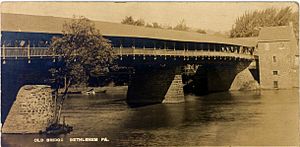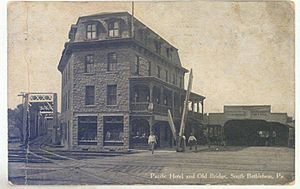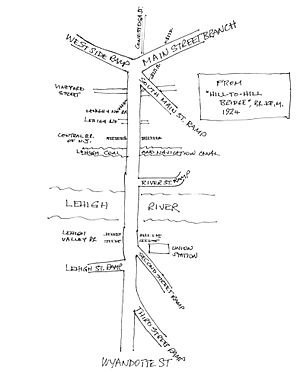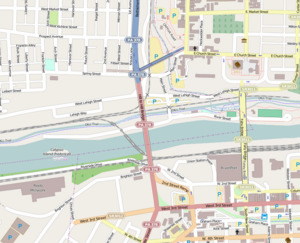Hill to Hill Bridge facts for kids
Quick facts for kids Hill to Hill Bridge |
|
|---|---|
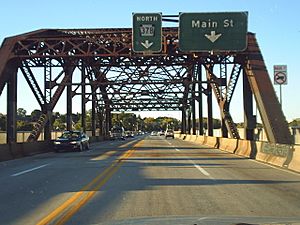
Hill to Hill Bridge heading northbound
|
|
| Coordinates | 40°36′56″N 75°23′05″W / 40.6155°N 75.3846°W |
| Carries | 4 lanes of |
| Crosses | Lehigh River |
| Locale | Bethlehem, Pennsylvania |
| Official name | Hill to Hill Bridge |
| Other name(s) | Route 378 Bridge |
| Characteristics | |
| Design | concrete arch truss bridge |
| History | |
| Opened | 1924 |
| Statistics | |
| Toll | Free |
The Hill to Hill Bridge is a road bridge that crosses the Lehigh River in Bethlehem, Pennsylvania. It connects the south and north sides of the city. This important bridge was finished in 1924. It carries Pennsylvania Route 378 and helps people travel easily between different parts of Bethlehem. The bridge replaced an older, smaller bridge and made travel much safer by avoiding railroad tracks at ground level. The Hill to Hill Bridge is part of the Central Bethlehem Historic District, which is a special area listed on the National Register of Historic Places.
Contents
History of the Bridge
The Old Bridge
Before Bethlehem became one big city in 1917, the north and south sides were separate towns. There were a few bridges connecting them. The main one was the Main Street covered bridge. This old bridge was quite narrow. It was often damaged by floods and ice in the river.
The old bridge also crossed several railroad tracks. This meant cars and people had to cross busy train lines at the same level as the tracks. This was dangerous. Imagine having to cross active train tracks just to get to a bridge! There was even a hotel, the Pacific Hotel, right next to the bridge entrance on the south side. Trains would pass right by it.
Building the New Bridge
Local leaders realized the old bridge was a problem. It made it hard for businesses and people to move between the two parts of Bethlehem. When the two towns joined to form one city, they had enough money and resources to build a new, better bridge.
In 1921, a special group was formed to plan the new bridge. The city's first mayor, Archibald Johnston, was in charge. Construction on the Hill to Hill Bridge began on August 1, 1921.
The new bridge was a huge project! It had many parts, including nine ways to get onto it (called approaches), many supports (piers and abutments), and 58 sections (spans). It was considered an amazing engineering feat for its time. By September 1924, the bridge was complete. It offered safe ways to cross the river and railroads without having to stop for trains.
Making the Bridge Modern
Over the years, the Hill to Hill Bridge was changed to keep up with modern traffic. After World War II, some big updates happened. One major change came when a new expressway, part of Route 378, was built north of the bridge. This new road, sometimes called the "Spur Route," changed how traffic flowed.
To make things safer and improve traffic, some of the bridge's ramps (the parts that connect to other streets) were removed. For example, a ramp leading to Sand Island was removed in 1988. These changes helped the bridge work better for the growing city.
The Hill to Hill Bridge Today
The bridge had major repairs in 1990. In 2009, it was painted. This painting project caused some traffic jams because two of the four lanes had to be closed. But the painting was finished just in time for the opening of the Sands Casino Resort Bethlehem (now Wind Creek Bethlehem). Today, the Hill to Hill Bridge continues to be a vital link for Bethlehem.
How the Bridge is Built
The Hill to Hill Bridge is famous for its many ramps and branches. It was designed by Clarence W. Hudson. The bridge uses a mix of strong concrete arches and steel truss sections. A truss is a framework of connected beams, usually in triangles, that makes a structure very strong.
One special thing about this bridge is how two of its truss sections were designed. They needed to be extra tall to go over the railroad tracks. Also, a ramp connected to the bridge right where one of these truss sections was. This meant the usual diagonal supports of a truss couldn't be used. So, the engineer, C.W. Hudson, created a new kind of truss design. This design is now called the Hudson truss. The Hill to Hill Bridge has the only known examples of this unique truss design.
Original Ramps and Crossings (1924)
When the bridge first opened in 1924, it had many connections:
- Wyandotte Street entrance
- Third Street ramp
- Lehigh (now Brighton) Street ramp
- Second Street ramp
- It crossed the Lehigh Valley Railroad tracks
- It crossed the Lehigh River
- River Street ramp
- It crossed the Lehigh Coal and Navigation Canal
- It crossed the Central Railroad of New Jersey tracks
- It crossed Lehigh Avenue
- It crossed the Lehigh and New England Railroad
- It crossed Vineyard Street
- It crossed Spring Street
- South Main Street ramp
- West Side ramp
- Main Street Branch
- It crossed Main Street
Current Ramps and Crossings
Today, the Hill to Hill Bridge has fewer ramps, but it's still a complex structure:
- Wyandotte Street entrance
- Second Street ramp
- Brighton Street ramp
- It crosses the Norfolk Southern Railroad tracks
- It crosses the Lehigh River
- It crosses more Norfolk Southern Railroad tracks
- It crosses West Lehigh Street
- It crosses Spring Street
- Main Street/Bridge Street ramp
- Pennsylvania Route 378 ("Spur Route") entrance
Gallery
-
Bridge spans over Lehigh River.
-
Bridge span over Lehigh Canal.
Images for kids
-
1906 photograph of the old bridge, which was replaced in September 1924 with the opening of Hill to Hill Bridge, which crosses the Lehigh River and connects Bethlehem, Pennsylvania's north and south side.


